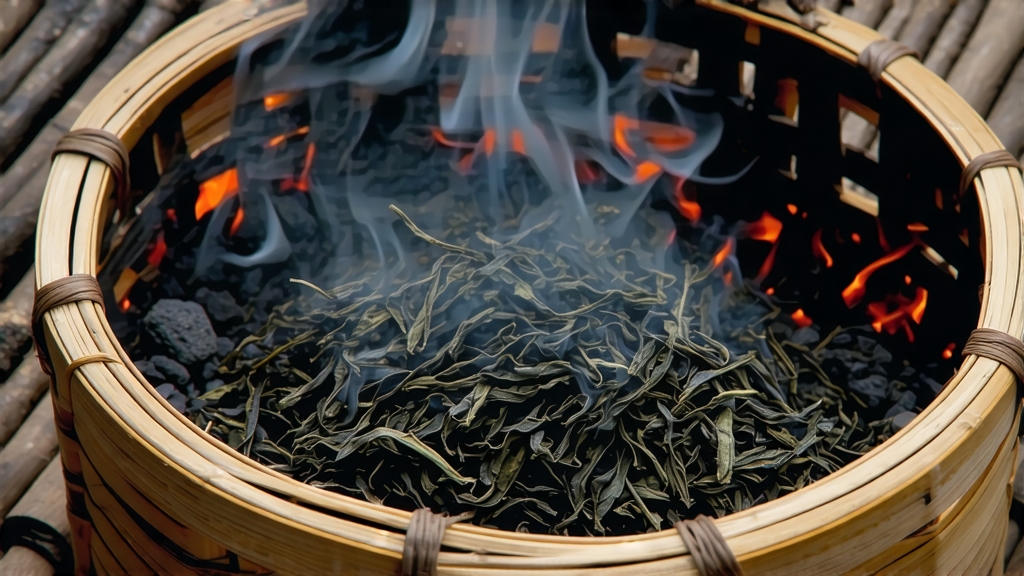
Long before English breakfast tables knew the word “black tea,” caravans loaded with dark, leathery leaves left the granite gorges of northern Fujian. Those leaves were Lapsang Souchong—today celebrated as the first fully oxidised tea ever created, the prototype that launched the global category we now call “black.” To understand it is to taste the moment when Chinese green-tea craftsmanship pivoted into something deeper, sweeter, and infinitely transportable.
Origin & Myth
The Wuyi Mountains rise like a row of broken teeth along Fujian’s border with Jiangxi. Their cliffs trap humid monsoon clouds, creating a perpetual mist that slows leaf growth and concentrates sugars. Local folklore credits the birth of Lapsang to a passing Qing-dynasty army that commandeered a tea factory in Tongmu village. To meet the next day’s market deadline, workers dried the leaves over fresh pine fires, accidentally infusing them with resinous smoke. Merchants in Xiamen loved the result, Dutch traders loved it even more, and by 1604 the first chests reached Amsterdam, priced higher than spices.
Terroir & Cultivar
True Lapsang Souchong can only come from Tongmu and three neighbouring hamlets inside the 60,000-hectare Wuyi National Nature Reserve. The soil is a stony, mineral-rich laterite locals call “purple sand.” The dominant cultivar is Xiao Ye Zhong (“small-leaf species”), a slow-growing shrub whose leaves are barely half the size of those used for Assam or Ceylon. At 600–1,200 m elevation, spring nights can dip to 8 °C; the cold shock forces the plant to convert starches into fragrant amino acids, giving the finished tea its signature longan-sweet core.
Two Faces: Smoke & No-Smoke
International consumers usually picture a tar-black, intensely smoky leaf, yet within China connoisseurs prize an unsmoked, fruit-forward version called “Zheng Shan Xiao Zhong.” Both styles share the same plucking standard—one bud, two or three leaves—but diverge at the firing stage. The smoked style (wǔ xūn) is withered over pine embers, rolled, oxidised, then finished above a pinewood hearth so that benzaldehyde and guaiacol vapours penetrate the leaf. The unsmoked style (wú xūn) is withered naturally in heated rooms, then charcoal-baked at 70 °C for eight hours, yielding notes of dried apricot, honey and wet slate.
Craft in Slow Motion
Plucking begins at Qingming (early April) when the bud’s first scale unfurls. Leaves are laid 3 cm deep on bamboo trays suspended inside the second floor of wooden houses; smoke from the ground-level hearth drifts upward through slatted floors. Every 20 minutes the tea master flips the leaves by hand, judging moisture by the coolness of the pile against his cheek. Once the leaf loses 60 % of its weight it is rolled for 45 minutes under low pressure to rupture cell walls without breaking the waxy cuticle. Oxidation follows in cedar-lined chests kept at 24 °C and 85 % humidity; colour shifts from jade to copper in exactly two hours. The critical “final bake” uses 40-year-old Masson pine logs that have air-dried for two seasons; green wood would impart harsh resin. Temperature hovers at 90 °C while the master smells for the moment when smoke transitions from sharp to candied—usually 3–4 minutes. Total processing time: 18 meticulous hours.
Grading Language
Western tea catalogues often list “Lapsang Souchong OP” or “Broken Lapsang,” but these are outside imitations. Inside Tongmu the grades are:
- Premium Qing Ming One Bud One Leaf (silver-tipped, minimal smoke)
- Special Chao Qing (deeply smoked, longan aroma)
- Ji Pin (picked before 10 a.m., baked over charcoal only)
- Lao Cong (from 80-year-old shrubs, unsmoked, honeyed minerality)
Brewing: Gongfu vs. Western
Gongfu style unlocks the layered personality. Use 5 g in a 120 ml porcelain gaiwan, 95 °C water, flash rinse, then steep 5 s, 5